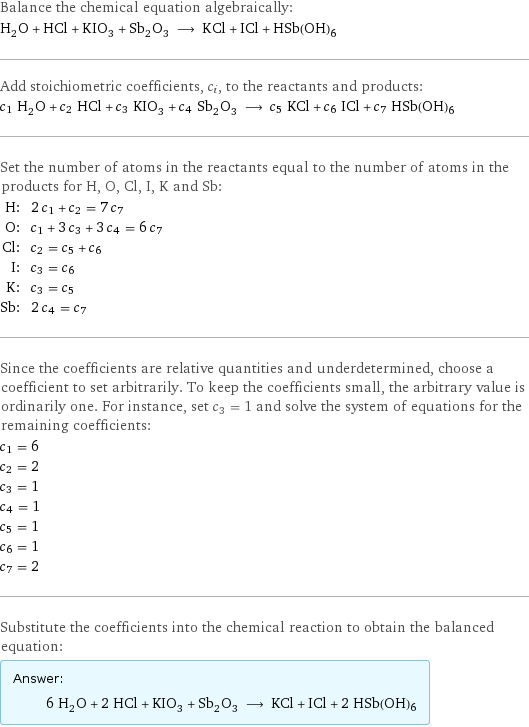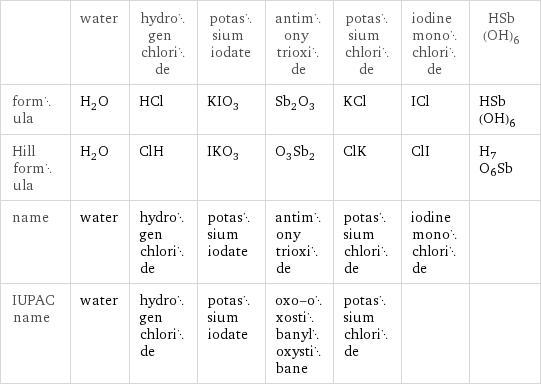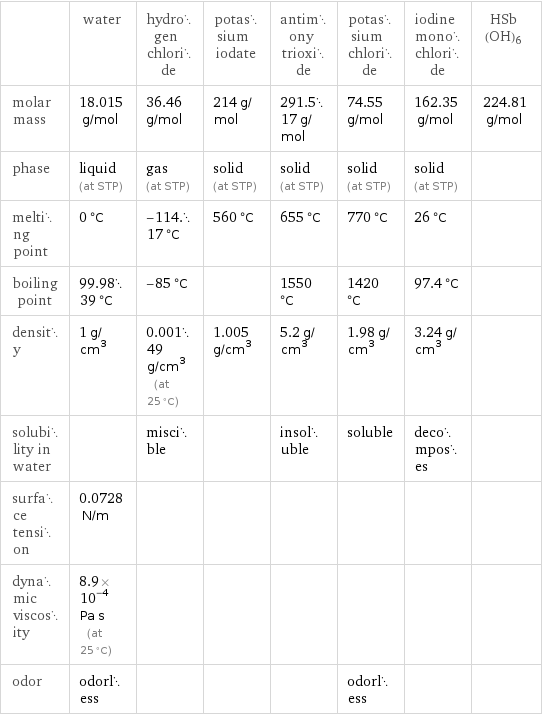Input interpretation

H_2O water + HCl hydrogen chloride + KIO_3 potassium iodate + Sb_2O_3 antimony trioxide ⟶ KCl potassium chloride + ICl iodine monochloride + HSb(OH)6
Balanced equation

Balance the chemical equation algebraically: H_2O + HCl + KIO_3 + Sb_2O_3 ⟶ KCl + ICl + HSb(OH)6 Add stoichiometric coefficients, c_i, to the reactants and products: c_1 H_2O + c_2 HCl + c_3 KIO_3 + c_4 Sb_2O_3 ⟶ c_5 KCl + c_6 ICl + c_7 HSb(OH)6 Set the number of atoms in the reactants equal to the number of atoms in the products for H, O, Cl, I, K and Sb: H: | 2 c_1 + c_2 = 7 c_7 O: | c_1 + 3 c_3 + 3 c_4 = 6 c_7 Cl: | c_2 = c_5 + c_6 I: | c_3 = c_6 K: | c_3 = c_5 Sb: | 2 c_4 = c_7 Since the coefficients are relative quantities and underdetermined, choose a coefficient to set arbitrarily. To keep the coefficients small, the arbitrary value is ordinarily one. For instance, set c_3 = 1 and solve the system of equations for the remaining coefficients: c_1 = 6 c_2 = 2 c_3 = 1 c_4 = 1 c_5 = 1 c_6 = 1 c_7 = 2 Substitute the coefficients into the chemical reaction to obtain the balanced equation: Answer: | | 6 H_2O + 2 HCl + KIO_3 + Sb_2O_3 ⟶ KCl + ICl + 2 HSb(OH)6
Structures

+ + + ⟶ + + HSb(OH)6
Names

water + hydrogen chloride + potassium iodate + antimony trioxide ⟶ potassium chloride + iodine monochloride + HSb(OH)6
Equilibrium constant
![Construct the equilibrium constant, K, expression for: H_2O + HCl + KIO_3 + Sb_2O_3 ⟶ KCl + ICl + HSb(OH)6 Plan: • Balance the chemical equation. • Determine the stoichiometric numbers. • Assemble the activity expression for each chemical species. • Use the activity expressions to build the equilibrium constant expression. Write the balanced chemical equation: 6 H_2O + 2 HCl + KIO_3 + Sb_2O_3 ⟶ KCl + ICl + 2 HSb(OH)6 Assign stoichiometric numbers, ν_i, using the stoichiometric coefficients, c_i, from the balanced chemical equation in the following manner: ν_i = -c_i for reactants and ν_i = c_i for products: chemical species | c_i | ν_i H_2O | 6 | -6 HCl | 2 | -2 KIO_3 | 1 | -1 Sb_2O_3 | 1 | -1 KCl | 1 | 1 ICl | 1 | 1 HSb(OH)6 | 2 | 2 Assemble the activity expressions accounting for the state of matter and ν_i: chemical species | c_i | ν_i | activity expression H_2O | 6 | -6 | ([H2O])^(-6) HCl | 2 | -2 | ([HCl])^(-2) KIO_3 | 1 | -1 | ([KIO3])^(-1) Sb_2O_3 | 1 | -1 | ([Sb2O3])^(-1) KCl | 1 | 1 | [KCl] ICl | 1 | 1 | [ICl] HSb(OH)6 | 2 | 2 | ([HSb(OH)6])^2 The equilibrium constant symbol in the concentration basis is: K_c Mulitply the activity expressions to arrive at the K_c expression: Answer: | | K_c = ([H2O])^(-6) ([HCl])^(-2) ([KIO3])^(-1) ([Sb2O3])^(-1) [KCl] [ICl] ([HSb(OH)6])^2 = ([KCl] [ICl] ([HSb(OH)6])^2)/(([H2O])^6 ([HCl])^2 [KIO3] [Sb2O3])](../image_source/f8a130406453f725e03859f760635b45.png)
Construct the equilibrium constant, K, expression for: H_2O + HCl + KIO_3 + Sb_2O_3 ⟶ KCl + ICl + HSb(OH)6 Plan: • Balance the chemical equation. • Determine the stoichiometric numbers. • Assemble the activity expression for each chemical species. • Use the activity expressions to build the equilibrium constant expression. Write the balanced chemical equation: 6 H_2O + 2 HCl + KIO_3 + Sb_2O_3 ⟶ KCl + ICl + 2 HSb(OH)6 Assign stoichiometric numbers, ν_i, using the stoichiometric coefficients, c_i, from the balanced chemical equation in the following manner: ν_i = -c_i for reactants and ν_i = c_i for products: chemical species | c_i | ν_i H_2O | 6 | -6 HCl | 2 | -2 KIO_3 | 1 | -1 Sb_2O_3 | 1 | -1 KCl | 1 | 1 ICl | 1 | 1 HSb(OH)6 | 2 | 2 Assemble the activity expressions accounting for the state of matter and ν_i: chemical species | c_i | ν_i | activity expression H_2O | 6 | -6 | ([H2O])^(-6) HCl | 2 | -2 | ([HCl])^(-2) KIO_3 | 1 | -1 | ([KIO3])^(-1) Sb_2O_3 | 1 | -1 | ([Sb2O3])^(-1) KCl | 1 | 1 | [KCl] ICl | 1 | 1 | [ICl] HSb(OH)6 | 2 | 2 | ([HSb(OH)6])^2 The equilibrium constant symbol in the concentration basis is: K_c Mulitply the activity expressions to arrive at the K_c expression: Answer: | | K_c = ([H2O])^(-6) ([HCl])^(-2) ([KIO3])^(-1) ([Sb2O3])^(-1) [KCl] [ICl] ([HSb(OH)6])^2 = ([KCl] [ICl] ([HSb(OH)6])^2)/(([H2O])^6 ([HCl])^2 [KIO3] [Sb2O3])
Rate of reaction
![Construct the rate of reaction expression for: H_2O + HCl + KIO_3 + Sb_2O_3 ⟶ KCl + ICl + HSb(OH)6 Plan: • Balance the chemical equation. • Determine the stoichiometric numbers. • Assemble the rate term for each chemical species. • Write the rate of reaction expression. Write the balanced chemical equation: 6 H_2O + 2 HCl + KIO_3 + Sb_2O_3 ⟶ KCl + ICl + 2 HSb(OH)6 Assign stoichiometric numbers, ν_i, using the stoichiometric coefficients, c_i, from the balanced chemical equation in the following manner: ν_i = -c_i for reactants and ν_i = c_i for products: chemical species | c_i | ν_i H_2O | 6 | -6 HCl | 2 | -2 KIO_3 | 1 | -1 Sb_2O_3 | 1 | -1 KCl | 1 | 1 ICl | 1 | 1 HSb(OH)6 | 2 | 2 The rate term for each chemical species, B_i, is 1/ν_i(Δ[B_i])/(Δt) where [B_i] is the amount concentration and t is time: chemical species | c_i | ν_i | rate term H_2O | 6 | -6 | -1/6 (Δ[H2O])/(Δt) HCl | 2 | -2 | -1/2 (Δ[HCl])/(Δt) KIO_3 | 1 | -1 | -(Δ[KIO3])/(Δt) Sb_2O_3 | 1 | -1 | -(Δ[Sb2O3])/(Δt) KCl | 1 | 1 | (Δ[KCl])/(Δt) ICl | 1 | 1 | (Δ[ICl])/(Δt) HSb(OH)6 | 2 | 2 | 1/2 (Δ[HSb(OH)6])/(Δt) (for infinitesimal rate of change, replace Δ with d) Set the rate terms equal to each other to arrive at the rate expression: Answer: | | rate = -1/6 (Δ[H2O])/(Δt) = -1/2 (Δ[HCl])/(Δt) = -(Δ[KIO3])/(Δt) = -(Δ[Sb2O3])/(Δt) = (Δ[KCl])/(Δt) = (Δ[ICl])/(Δt) = 1/2 (Δ[HSb(OH)6])/(Δt) (assuming constant volume and no accumulation of intermediates or side products)](../image_source/868f26bb71a776686cf0988a67753195.png)
Construct the rate of reaction expression for: H_2O + HCl + KIO_3 + Sb_2O_3 ⟶ KCl + ICl + HSb(OH)6 Plan: • Balance the chemical equation. • Determine the stoichiometric numbers. • Assemble the rate term for each chemical species. • Write the rate of reaction expression. Write the balanced chemical equation: 6 H_2O + 2 HCl + KIO_3 + Sb_2O_3 ⟶ KCl + ICl + 2 HSb(OH)6 Assign stoichiometric numbers, ν_i, using the stoichiometric coefficients, c_i, from the balanced chemical equation in the following manner: ν_i = -c_i for reactants and ν_i = c_i for products: chemical species | c_i | ν_i H_2O | 6 | -6 HCl | 2 | -2 KIO_3 | 1 | -1 Sb_2O_3 | 1 | -1 KCl | 1 | 1 ICl | 1 | 1 HSb(OH)6 | 2 | 2 The rate term for each chemical species, B_i, is 1/ν_i(Δ[B_i])/(Δt) where [B_i] is the amount concentration and t is time: chemical species | c_i | ν_i | rate term H_2O | 6 | -6 | -1/6 (Δ[H2O])/(Δt) HCl | 2 | -2 | -1/2 (Δ[HCl])/(Δt) KIO_3 | 1 | -1 | -(Δ[KIO3])/(Δt) Sb_2O_3 | 1 | -1 | -(Δ[Sb2O3])/(Δt) KCl | 1 | 1 | (Δ[KCl])/(Δt) ICl | 1 | 1 | (Δ[ICl])/(Δt) HSb(OH)6 | 2 | 2 | 1/2 (Δ[HSb(OH)6])/(Δt) (for infinitesimal rate of change, replace Δ with d) Set the rate terms equal to each other to arrive at the rate expression: Answer: | | rate = -1/6 (Δ[H2O])/(Δt) = -1/2 (Δ[HCl])/(Δt) = -(Δ[KIO3])/(Δt) = -(Δ[Sb2O3])/(Δt) = (Δ[KCl])/(Δt) = (Δ[ICl])/(Δt) = 1/2 (Δ[HSb(OH)6])/(Δt) (assuming constant volume and no accumulation of intermediates or side products)
Chemical names and formulas

| water | hydrogen chloride | potassium iodate | antimony trioxide | potassium chloride | iodine monochloride | HSb(OH)6 formula | H_2O | HCl | KIO_3 | Sb_2O_3 | KCl | ICl | HSb(OH)6 Hill formula | H_2O | ClH | IKO_3 | O_3Sb_2 | ClK | ClI | H7O6Sb name | water | hydrogen chloride | potassium iodate | antimony trioxide | potassium chloride | iodine monochloride | IUPAC name | water | hydrogen chloride | potassium iodate | oxo-oxostibanyloxystibane | potassium chloride | |
Substance properties

| water | hydrogen chloride | potassium iodate | antimony trioxide | potassium chloride | iodine monochloride | HSb(OH)6 molar mass | 18.015 g/mol | 36.46 g/mol | 214 g/mol | 291.517 g/mol | 74.55 g/mol | 162.35 g/mol | 224.81 g/mol phase | liquid (at STP) | gas (at STP) | solid (at STP) | solid (at STP) | solid (at STP) | solid (at STP) | melting point | 0 °C | -114.17 °C | 560 °C | 655 °C | 770 °C | 26 °C | boiling point | 99.9839 °C | -85 °C | | 1550 °C | 1420 °C | 97.4 °C | density | 1 g/cm^3 | 0.00149 g/cm^3 (at 25 °C) | 1.005 g/cm^3 | 5.2 g/cm^3 | 1.98 g/cm^3 | 3.24 g/cm^3 | solubility in water | | miscible | | insoluble | soluble | decomposes | surface tension | 0.0728 N/m | | | | | | dynamic viscosity | 8.9×10^-4 Pa s (at 25 °C) | | | | | | odor | odorless | | | | odorless | |
Units
